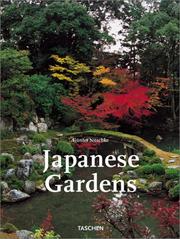| Listing 1 - 6 of 6 |
Sort by
|
Book
ISBN: 9784866580197 4866580194 Year: 2018 Publisher: Tokyo Japan Publishing Industry Foundation for Culture
Abstract | Keywords | Export | Availability | Bookmark
 Loading...
Loading...Choose an application
- Reference Manager
- EndNote
- RefWorks (Direct export to RefWorks)
"Securing the generous support of the politicians and industrialists who propelled Japan's modernization, Ogawa Jihei VII created many outstanding gardens at the end of the nineteenth and the first few decades of the twentieth century. Expressing a Japanese aesthetic even while incorporating modern techniques, his methodology reveals the nature of modernization as Japan experienced it. With a keen eye for architecture, the author takes a long-awaited look at modernization and the modern garden"--
Gardens --- J6586 --- History --- Japan: Art and antiquities -- urban planning -- parks and gardens. --- Ogawa, Jihē, --- Gardening --- Japan: Art and antiquities -- urban planning -- parks and gardens --- Ogawa, Jihei, --- 小川治兵衛,
Book
ISBN: 0834815079 Year: 1978 Publisher: New York Weatherhill
Abstract | Keywords | Export | Availability | Bookmark
 Loading...
Loading...Choose an application
- Reference Manager
- EndNote
- RefWorks (Direct export to RefWorks)
Book
ISBN: 9782913217416 2913217419 Year: 2020 Publisher: Paris: Collège de France. Institut des hautes études japonaises,
Abstract | Keywords | Export | Availability | Bookmark
 Loading...
Loading...Choose an application
- Reference Manager
- EndNote
- RefWorks (Direct export to RefWorks)
L’histoire de l’habitat japonais repose, depuis l’antiquité, sur une spatialité dans laquelle l’individu faisait partie intégrante de l’environnement naturel qui l’entourait. Cette symbiose entre l’être humain et la nature procède d’une longue histoire de la pensée japonaise et sino-japonaise. Elle est nourrie de mythes, de légendes, de sacré, depuis les cultes primitifs du Shintō, les courants de pensée venus de l’Inde via la Chine à travers le Bouddhisme, et l’influence majeure exercée par les conceptions taoïstes de l’univers. Ces apports successifs n’ont jamais remis en cause le rapport fondamental de l’être humain à la nature, mais lui ont apporté de nouvelles densités et ont imprimé leur marque sur toutes les formes d’expression de la société, dont l’architecture et le paysage. D’une certaine manière, l’architecture et les jardins japonais ont toujours reflété ce rapport fondamental de l’humain à la nature, et c’est pourquoi les divers archétypes de l’espace habité, de l’époque ancienne à l’époque moderne, se fondent sur ces liens intrinsèques à la nature. L’ouvrage rassemble les contributions de chercheurs réunis autour de Nicolas Fiévé sur les modes de conception et de production du paysage architectural et urbain au Japon, ainsi que sur la dynamique de ce paysage. « Paysage » s’entend au sens d’un artefact – un paysage façonné par l’humain – qui se donne à voir, à vivre et à ressentir dans les espaces habités. Les auteurs ont privilégié une approche qui cherche à comprendre les pratiques ou les discours sur le paysage du point de vue de la relation entre l’être humain et la nature.

ISBN: 3822820350 Year: 2003 Publisher: Köln Taschen
Abstract | Keywords | Export | Availability | Bookmark
 Loading...
Loading...Choose an application
- Reference Manager
- EndNote
- RefWorks (Direct export to RefWorks)
Book
ISBN: 9784901558815 4901558811 Year: 2016 Publisher: Kyoto International research center for Japanese studies
Abstract | Keywords | Export | Availability | Bookmark
 Loading...
Loading...Choose an application
- Reference Manager
- EndNote
- RefWorks (Direct export to RefWorks)
Gardens, Japanese. --- Gardens, Japanese --- Landscape gardening --- Landscape gardening. --- History. --- Japan. --- J6586 --- J6590 --- Japan: Art and antiquities -- urban planning -- parks and gardens --- Japan: Art and antiquities -- landscape architecture and gardens --- E-books
Book
ISBN: 9781780231907 9781780232317 1780232314 1299951074 1780231903 Year: 2013 Publisher: London Reaktion Books
Abstract | Keywords | Export | Availability | Bookmark
 Loading...
Loading...Choose an application
- Reference Manager
- EndNote
- RefWorks (Direct export to RefWorks)
The essential elements of a dry Japanese garden are few: rocks, gravel, moss. Simultaneously a sensual matrix, a symbolic form, and a memory theater, these gardens exhibit beautiful miniaturization and precise craftsmanship. But their apparent minimalism belies a true complexity. In Zen Landscapes, Allen S. Weiss takes readers on an exciting journey through these exquisite sites, explaining how Japanese gardens must be approached according to the play of scale, surroundings, and seasons, as well as in relation to other arts--revealing them as living landscapes rather than abstract designs. Weiss shows that these gardens are inspired by the Zen aesthetics of the tea ceremony, manifested in poetry, painting, calligraphy, architecture, cuisine, and ceramics. Japanese art favors suggestion and allusion, valuing the threshold between the distinct and the inchoate, between figuration and abstraction, and he argues that ceramics play a crucial role here, relating as much to the site-specificity of landscape as to the ritualized codes of the tea ceremony and the everyday gestures of the culinary table. With more than one hundred stunning color photographs, Zen Landscapes is the first in-depth study in the West to examine the correspondences between gardens and ceramics. A fascinating look at landscape art and its relation to the customs and craftsmanship of the Japanese arts, it will appeal to readers interested in landscape design and Japan's art and culture.
Gardens, Japanese --- Ceramic sculpture, Japanese --- Zen arts --- Zen Buddhism --- Art, Japanese --- J6586 --- J6640 --- Chʻan Buddhism --- Dhyāna (Sect) --- Zen --- Zen (Sect) --- Buddhism --- Mahayana Buddhism --- Arts, Zen --- Buddhist arts --- Japanese ceramic sculpture --- Zen influences --- Japan: Art and antiquities -- urban planning -- parks and gardens --- Japan: Art and antiquities -- industrial art, craft and design -- ceramics and glassware --- Ceramic sculpture, Japanese. --- Zen arts. --- Zen Buddhism. --- Zen influences.
| Listing 1 - 6 of 6 |
Sort by
|

 Search
Search Feedback
Feedback About UniCat
About UniCat  Help
Help News
News